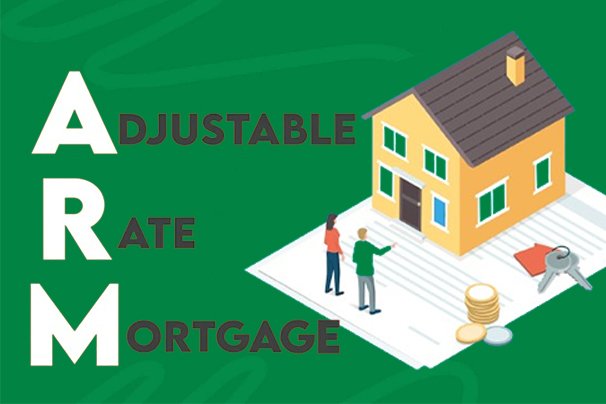An adjustable-rate mortgage (ARM) is a home loan with an interest rate that can change periodically based on market conditions. Initially, the interest rate is fixed for a set period, after which it adjusts based on a benchmark plus an additional margin. ARMs are suitable for borrowers planning to keep the loan for a limited time, benefiting from lower initial rates but facing potential payment increases if rates rise.

When considering an ARM, it’s crucial to understand key terms like index rate and margin, which determine the interest rate calculation. ARMs have caps that limit how much the interest rate can increase per adjustment period and over the life of the loan. Borrowers should carefully review all terms and conditions, especially regarding interest rate caps and potential penalties for early repayment.
How Does It Work?
An adjustable-rate mortgage (ARM) works by having an initial fixed period, typically 5, 7, or 10 years, where the interest rate remains constant. After this period, the interest rate adjusts periodically based on a benchmark index, potentially leading to fluctuations in monthly payments depending on market conditions.
The interest rate calculation for ARMs involves adding the index rate to a margin set by the lender. Caps are placed on how much the interest rate can increase per adjustment period and over the life of the loan to protect borrowers from drastic payment changes.
Borrowers considering ARMs should carefully review all terms and conditions, including interest rate caps and potential penalties for early repayment. Understanding the index used, margin percentage, and caps is crucial for making an informed decision about whether an ARM aligns with its financial goals and risk tolerance.
Types of Adjustable-Rate Mortgages (ARMs)
Three main types of adjustable-rate mortgages (ARMs) exist: hybrid, interest-only (IO), and payment options.
Hybrid ARMs:
These loans are a combination of fixed-rate and adjustable-rate periods. The interest rate is fixed for a specific period, followed by adjustments based on market conditions. Examples include 5/1, 5/6, 7/1, and 7/6 ARMs, where the first number represents the fixed-rate period and the second number indicates the adjustment frequency.
Interest-Only (IO) ARMs:
With IO ARMs, borrowers pay only the interest on the loan for a specified period, typically 5, 7, or 10 years. After this period, the borrower must pay the principal and interest.
Payment Options: ARMs:
These loans offer borrowers flexibility in choosing their monthly payments, often allowing them to pay more or less than the required amount. This can be beneficial for those with variable incomes.
Each type of ARM has its advantages and disadvantages, and the choice between them depends on the borrower’s financial situation, risk tolerance, and plans for the property.
Pros and cons of an ARM
Pros of an adjustable-rate mortgage (ARM) include lower initial fixed rates, potentially leading to lower monthly payments, and rate caps that limit how much the interest rate can increase. ARMs can benefit those planning to sell their home within a few years or expecting interest rates to decrease, offering flexibility and potential savings.
The cons of ARMs involve the possibility of interest rates increasing, leading to higher monthly payments, limited availability compared to fixed-rate mortgages, and the challenge of budgeting for fluctuating payments after the initial fixed period ends. Borrowers need to carefully assess their financial situation, risk tolerance, and long-term plans before opting for an ARM to ensure it aligns with their needs and goals.
ARM vs. Fixed-Rate Mortgage: Which one is good for you?
When deciding between an adjustable-rate mortgage (ARM) and a fixed-rate mortgage, consider the following factors:
Planning to move:
If you plan to sell your home within a few years, An ARM can be a good choice as it offers lower initial rates and payments, potentially saving you on interest.
Interest rates:
If you believe interest rates will decrease in the long run, an ARM could be beneficial, as the interest rate can go down as well as up.
Budgeting:
Fixed-rate mortgages offer a consistent monthly payment, making it easier to budget, while ARMs have adjustments that can be harder to predict and budget for, especially if you have an unpredictable income or struggle with budgeting.
Risk tolerance:
ARMs come with the risk of higher interest rates and payments in the future, while fixed-rate mortgages provide a stable payment for the life of the loan.
Financial goals:
If you want to own your home mortgage-free someday, a fixed-rate mortgage is a smart strategy when rates are low.
Ultimately, the choice between an ARM and a fixed-rate mortgage depends on your circumstances, including your financial situation, risk tolerance, and plans for the property.
What are the Different Types of ARMs?
ARMs come in various forms, like 3/1, 5/1, 7/1, and 10/1, indicating the fixed-rate period followed by adjustments. Understanding the fixed and floating-rate periods is crucial, as they determine when and how often your rate can change.
Is an ARM Suitable?
ARMs are ideal for those planning to sell during the fixed-rate period or with fluctuating income sources. However, they may not be suitable for those seeking consistent monthly payments or uncertain about future rate increases.
Will I save money with an ARM?
Initially, ARMs offer lower rates than fixed-rate mortgages, leading to short-term savings. Long-term savings depend on market conditions and a borrower’s ability to handle potential payment increases during the floating-rate period.
